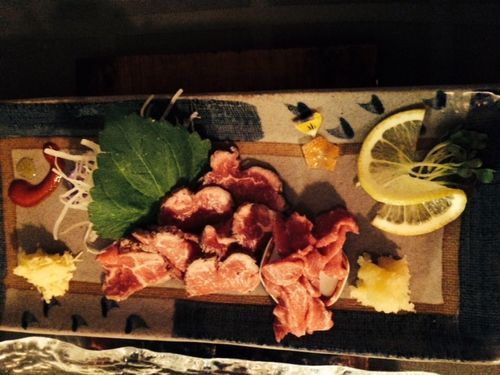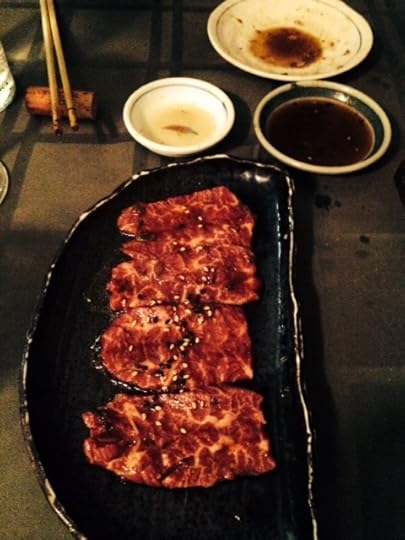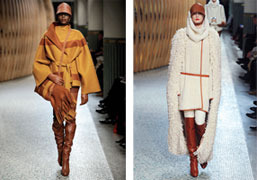Michael Tonello's Blog, page 34
February 18, 2014
They Managed to Drag an Hermes Kelly Bag Into Hollande's White House Visit
But in their appearances together and at the dinner in the Frenchman's honor, one question will cross many people's minds: What in the world do women see in him?

 This isn't a question that would be asked about the buff and almost ostentatiously uxorious Barack Obama. We're talking about the "short man with a bit of a paunch," as French reporters describe their Socialist president. On his motor scooter, his black lace-up shoes the only giveaway, he could be a professor of sociology on his way to teach at the Ecole Normale Superieure. So why do Hollande's sexual escapades continue to hold fascination for the intellectual elite in France and abroad?
This isn't a question that would be asked about the buff and almost ostentatiously uxorious Barack Obama. We're talking about the "short man with a bit of a paunch," as French reporters describe their Socialist president. On his motor scooter, his black lace-up shoes the only giveaway, he could be a professor of sociology on his way to teach at the Ecole Normale Superieure. So why do Hollande's sexual escapades continue to hold fascination for the intellectual elite in France and abroad?For one thing, the mistresses of the nondashing Hollande tend to be dashing themselves: first, the once "radiant" Segolene Royal, the Socialist politician who is the mother of his four children (they never married); then Valerie Trierweiler, a political journalist (they never married); and now Julie Gayet, the actress who ignited the scandal one evening in mid-January when a helmeted Hollande was spotted alighting from a motor scooter in front of her apartment (there hasn't been time yet for them to not marry).
We have learned that all Le President's Women isn't about the sex, or not just about the sex. What distinguishes Hollande's affairs is class. Not for the president of France the prostitutes and women of dubious provenance, the White House interns and weird acolytes of Carlos Danger, who have brought down or humiliated so many American politicians. Hollande isn't Client No. 9. His companions radiate chic.
Anyway, how unusual is it for a man of such considerable power to have a girlfriend, or two, on the side? It isn't as if French presidents, or the French in general, have ever been known for sexual austerity. Consider Hollande's predecessors. Nicolas Sarkozy took up with the glamorous Carla Bruni after his divorce from his glamorous second wife; Jacques Chirac's dalliances were widely known; Francois Mitterrand secretly had a child by his mistress. It would be hard to find a king in the line of Louis who didn't have adulterous dalliances. (Louis III died after falling off his horse — the scooter of the ninth century — in pursuit of a girl. He wasn't married, though, so I guess he doesn't count.)
When it comes to sex, the French are different from you and me. It's a theme in their literature, from the experiments of the Marquis de Sade to that classic of sadomasochism, "Histoire d'O," and the louche novels of Michel Houellebecq, with their forays into sex tourism. Then there is "The Sexual Life of Catherine Millet," a self-billed autobiographical account of orgies and other sexual practices of the Paris intelligentsia. (One pastime involved forming automobile caravans in the Bois de Boulogne and driving to a private house for anonymous group sex.)
Probity isn't part of it. Like most politicians, Hollande lies. Running against Sarkozy, he declared: "I, president of the republic, will make sure that my behavior is exemplary at every moment." It depends what the meaning of "exemplary" is. And he throws his weight around, putting Gayet on an arts jury until protests erupted and she was forced to withdraw. He dispenses patronage, installing Trierweiler in the "madam wing" of the Elysee Palace. But isn't that how the system works? In Diane Johnson's Paris-based novel, "Le Divorce," the young American mistress gets an Hermes Kelly bag, which every French woman recognizes as the adulterer's gift.
The main criticism of Hollande isn't that his conduct is immoral, but that it's undignified. "He looks totally ridiculous," said Sarkozy (who had set his own standard for looking totally ridiculous). Bruni's mother piled on, saying Hollande was a "jerk."
"This makes the French look like idiots," the proprietress of a restaurant in Tulle, the city in central France where Hollande served as mayor, complained to The New York Times.
In anticipation of a long-scheduled meeting with Pope Francis, Le Monde ran a cartoon that depicted the president arriving for his audience on a scooter with two women on the back. "Who am I to judge?" the pope says.
But the zealous attention to his sex life hasn't been all bad for Hollande. Seventy-seven percent of French voters considered the affair a private matter and disapproved of the panting coverage. In fact, his low approval rating briefly rose after revelations of the affair, especially among women. Men who misbehave, it seems, are sexy.
It's in other areas that Hollande gets into trouble. Tens of thousands of protesters took to the streets of Paris and Lyon on Feb. 2 to register their objections to the government's liberal policies on gay rights (surrogate parenthood, non!). By Monday, his government had shelved a "family reform bill" on the grounds that it needed more work.
Yet on his trip to Washington, everyone will want a glimpse of this man whom women love, who disregards social norms and does what he wants. He's kind of a jerk. So what? Most of us are.
Trierweiler once called her ex-lover a "normal man" and meant it as a compliment. For all the commotion, that's just what he is, in France anyway.
By James Atlas
Bloomberg
International Bestselling Author Barbara Taylor Bradford and Her 22 Hermes Kelly Bags
 Barbara Taylor Bradford: Fond of Paris, still to get to Hong Kong, never forgets Leeds
Barbara Taylor Bradford: Fond of Paris, still to get to Hong Kong, never forgets LeedsWhere do you holiday?
My husband Bob and I enjoy travelling, and after selling our 14-room New York apartment to Uma Thurman we are in temporary accommodation, and keen to take lots of holidays.
We are about to embark on a cruise. A friend is celebrating her birthday and has chartered a ship and invited 200 friends.
Favourite destination?
Two - the South of France and Paris. The first for relaxing in the sun, the second for shopping. Bob has a fantastic eye and always picks out wonderful clothes and handbags for me.
What do you never travel without?
I should say Bob, but I never go anywhere without my Hermes Kelly bag. I have 22. Did you know it's named after Princess Grace of Monaco? It's perfect for essentials: passport, purse, phone, make-up.
Place you want to visit?
Hong Kong. I've been nearly everywhere else. Bob made a film there of one of my books and took Lindsay Wagner, Christopher Cazenove and Stephanie Beecham, but I had to make a speech in Florida so couldn't make it.
Sun or snow?
We live in New York, where the summers are fine, but in winter we like the sun. My book is currently number one in Australia so we might take in a bit of the Australian summer.
Where do you feel most at home?
England. I'm a Yorkshire girl who started work on the local paper in Leeds with Keith Waterhouse. I haven't lost my accent and I still have my British passport. We don't have a permanent base here, but the Dorchester Hotel is a home from home.
How do you while away the time at the airport and on flights?
I read vociferously. Either biographies or history.
By http://www.dailymail.co.uk/travel/art...
Kanye West Knew People Would Hate Kim Kardashian's Painted Birkin Bag

"This past Christmas, Kanye West got fiancé Kim Kardashian an Hermes Birkin bag that caused a lot of talk in the fashion world. While Birkin is a huge name in fashion, this one was a little different than the typical bag. The gift was hand-painted by artist George Condo and featured three nude women on it, alongside a freakish monster.
This wasn’t the first time West and the artist got together. Back in 2010, Condo did the artwork for Kanye’s My Beautiful Dark Twisted Fantasy album. But this particular bag, which Kardashian absolutely loved, got people talking in a negative way. Fashionista reports that people used adjectives like “horrific,” “disgusting,” “vile,” “tasteless” and “terrible” to describe the bag. West was completely unfazed by all this negative talk though because he actually anticipated it the whole time.
This creation truly was one-of-a-kind, and her fans didn't like it nearly as much as his did. Recently, Condo spoke with W Magazine about the particular bag. “Kanye and I both knew immediately that people who knew our collaboration would think it was fun but that Kim’s fan base would go berserk,” he told the magazine in an interview.
He then went on to explain that the whole point of this was to take such an icon in the fashion consumerism world and change it up. “You can’t do this! It short circuits people’s concept of what’s untouchable, which is why it was fun to do," he said.
People have a specific image for what a Birkin bag entails, and this was nothing of the ordinary. Condo even admitted that the bag only took him 15 minutes to paint.
Condo and Kanye wanted it to make an impact on her fan base. “If I had just done it and put it in my closet, it wouldn’t mean a thing. But when you stick that bag in the hands of Kim Kardashian, well, then you create a whole different atmosphere. It’s about context,” he explained.
Kardashian is arguably an icon in the fashion world, and people who keep up with her didn’t really know how to react to the painting, since it’s unlike anything people usually put on such expensive bags.
Us Weekly reports that West, who is known for pushing boundaries, made an announcement at his most recent concert at Penn State University on Thursday, Feb. 13 that seems to be related to the release of this bag.
“Everybody’s so scared of trouble,” he said. “But I’d be more afraid of not having the love of ya’ll. I’d be more afraid of not giving you everything that I got. I’d be more afraid of turning into one of these people inside of the system that’s so scared to do anything. To say anything. And controlled by everything. And they don’t believe in anything.”
West then went on to thank his fans for all they do and for always loving and supporting him. “Ya’ll don’t give a f**k what happen,” he said. “Don’t say s**t about Ye!” Apparently, West won’t be letting anybody bring him down in 2014. He plans to be true to himself and express himself out loud, as he usually does.
So even though West and Condo realize this painting basically ruined the iconic Birkin bag, that’s not what it’s about. The two believe in putting anything they like out there and knowing their fans will support them no matter what. They knew Kardashian’s fans wouldn’t be into the painting, but they’re just trying to get her fans to be more like West’s fans, by supporting him no matter what he does."
-By Gina Masilotti, 2/16/2014
http://thecelebritycafe.com/feature/2...

February 17, 2014
Hermes Chanel Dior - It's All In the Details
The art of making pleats, while crucial in the world of haute couture—which holds six days of fashion shows in Paris next week—has become a rarity, with less than five “plisseurs” remaining in France.
Most of them practice their craft in the heart of Paris where four generations have moulded material into a mind-boggling array of pleats since Emilie Lognon opened the workshop in 1853, passing the craft onto three male descendants.
But last summer her great grandson Gerard-George retired and without an heir to take over, the workshop was bought by Chanel which has swept up a variety of traditional craft-houses to preserve their skills.
Embroiderers, feather workers, milliners, glovemakers and bootmakers have been grouped under the subsidiary Paraffection, but the specialist workshops remain independent.
In the Lognon workshop, located in central Paris, between the Opera and Place Vendome, three plisseurs are hard at work, surrounded by paper moulds.
The workshop is steeped in history from ceiling to its parquet flooring, which is listed from the period of Louis XIV and cannot be replaced.
Gerard-George Lognon often said he added a noble touch to fabric through pleating, an art much like origami, with each different fold creating different results.
“It is like sculpting clothing,” says Leopoldine Pataa, a 34-year-old pleat maker at the workshop.
One example is the sunburst pleat, perfect for flared skirts such as the famous white dress worn by Marilyn Monroe in the movie “The Seven Year Itch”.
Then the soft, drapey bias pleat, reminiscent of Grecian robes, box pleat—think cheerleader’s skirt—or the very narrow crystal pleat used on tuxedos.
Lognon invented a few of his own pleat styles, and the workshop has some 2,500 moulds used to make about 2,000 different kinds of pleats.
To make a sunburst pleat Pataa lays out one of the moulds on a large table, painstakingly sliding the material between the two cardboard layers—resembling a large, opened fan—before folding it once again.
The mould is then placed in a vapour oven for between two and five hours depending on the material. Once removed it needs to rest for several hours.
“For one piece, it can take a day,” explains Nadine Duffat from Lemarie, another craft house in Paris that belongs to Paraffection and one of the last feather-making houses.
Some can also be made by machine.
For the haute couture collections to be unveiled from Monday the pleat makers have worked on pieces for fashion giants Chanel, Dior and Venezuelan designer Oscar Carvallo. They have also worked on ready-to-wear collections for Chanel and Hermes.
“It is a unique know-how ... a craft that is essential to haute couture and high-end ready-to-wear,” said Duffat.

AFP-Relaxnews
http://www.themalaymailonline.com/fea...
Has The Hermes Birkin Bag Lost Its Appeal?
"Has the Hermès Birkin bag lost its appeal?"; but then never goes on to answer his own question.
At one point the author, Blue Carreon consults with "Popular blogger Bagaholicboy who hails from Singapore had this to say: “Truth be told, I’m honestly still puzzled why the Birkin is still so coveted."
Well I'm not puzzled.
The bottom line is this: The Hermès Birkin Bag has not lost its appeal.
At the end of the day no other bag has come along to replace the Birkin bag. It's as simple as that. There is no other bag that is so coveted. There is no other bag that is so difficult to obtain. There is no other bag that is considered "the ultimate status symbol". There is no other bag that "represents success, achievement and status" the way an Hermès Birkin does.
Until that day, until that other bag comes along, then the Birkin bag will continue to hold it's #1 position in the handbag pecking order.
#1

February 16, 2014
All The Rage with the Hermès Birkin / Beverly Hills - Malibu Crowd
This is one of those places people whisper about. “You mean you really got in?” They look at you suspiciously. “How?”
The restaurant is so wary of unknown customers that it disguises itself as an empty storefront. It doesn’t take reservations. If you somehow get the phone number, the woman who answers will tell you they are fully booked. Forever.
But if you know someone, who knows someone....
First off, it doesn’t look like much. The kitchen occupies half the restaurant, the tables are modest, and the odd screens shielding the tables look as if they were rescued from a hospital that went out of business in the fifties. Dusty (empty) bottles of (very fancy) wine (red), sit on top of the wall separating the kitchen from the dining room. This then, is all about the food.
All about the beef, in fact; this is a meat-eater’s paradise, the meal I wanted to have in Osaka, the meal I couldn’t get because I could not make myself understood in that city’s equivalent of this restaurant. Although we were able to procure a reservation for the Osaka restaurant, we got there to discover that nobody spoke English. We ordered by pointing at the food on other people’s tables. All I can say is - we ordered wrong.
At Totoraku, however, you don't order. You bring your own wine, and they bring you food. Last night's meal went like this:

This elegant platter of tiny tastes is the one non-meat offering. It contains (amon other little tidbits) a tangle of shrimp topped with caviar, fragrant Japanese uni, crisp abalone, sesame tofu, wild yellowtail, delicate little avocado rolls and a dish of pickled cucumber topped with crisp bits of jellyfish.

Tender slices of raw beef.

Beef tartar in the Korean style: cold squiggles of beef with Asian pear, sesame and a quail egg yolk.

More beef, served with grated horseradish and a garlic paste. The joy here is the raw beef on the right, which comes from the throat; smooth and silky, with the texture of toro, it simply evaporates in your mouth.

Now the hibachi comes out, along with a parade of different cuts. I'm sorry to say I liked the soft, rich slices of tongue so much that I forgot to photograph them. Then there was this platter of filet mignon - the least impressive meat of the night - with lovely vegetables to grill. (There was also, full disclosure, a basket of raw vegetables, some marinated tomatoes, and a miso-based sauce to dip them in.)

Outside ribeye (this is the long muscle on the outside of a ribeye, which many consider the single best piece of meat on the animal).

Inside ribeye - fascinating, the different texture of this cut.

Boneless shortrib - my favorite of the lot.

And finally, the soup with a bit of egg, spinach, and just a tiny scoop of rice. A perfect ending to the meal.
There was completely unnecessary sorbet for dessert. In the end, what you remember is the meat. Chef Kaz Oyama won't say where ihe sources it, but it was, truly, spectacular.
http://www.ruthreichl.com/2014/02/the...
OH, and something Ms Reichl doesn't tell you:
10610 W Pico Blvd
Los Angeles, California 90064
Phone (310) 838-9881
February 15, 2014
Hermès Menswear Artistic Director Veronique Nichanian
 Hermes designer Nichanian: a woman in a man’s worldFrenchwoman Veronique Nichanian, the artistic director for Hermes, stands out in the fashion world as one of the only women to create men’s styles. That she has been doing it for 26 years is another rarity. “I always feel the same anxiety,” she admitted ahead of her catwalk show Saturday in Paris. “But the enthusiasm is always solid,” she told AFP with a smile. She says Hermes’s then boss Jean-Louis Dumas told her when he tapped her in 1988: “Manage this like your little enterprise. You have carte blanche.” Nichanian was previously with Nino Cerruti, who had hired her straight out of design school. The diminutive designer says she had to “work harder” and “be determined” as a woman in a man’s world and was “pretty proud” of her longevity. “It was a pretty macho milieu and the men didn’t expect a woman to tell them what to do,” she recalls. Nichanian came into the work “by chance, at first. Then I discovered a rigour in men’s fashion, as a person who is not a fan of unnecessary details.” The 50-something designer said she had wanted to work in fashion since she was an adolescent, noting that while her parents were not in the business they were “very elegant people”. She described the “discreet chic” of her father of Armenian origin, and how her mother and grandmother had Hermes handbags and scarves. The elegant brunette with sparkling eyes said she draws inspiration from myriad sources — “in the street... in what I read... at shows.” But with Hermes, whose sales of men’s ready-to-wear enjoyed double-digit growth last year, “it’s a continuing story”. While there are not radical changes from one show to the next, “the wardrobe gets richer from collection to collection,” she says. “Some cuts don’t change at all, or only by millimetres.” And since Hermes clothes tend to be pricy, men will not stop wearing them after the season is up, she said. “I’ve looked at collections from 20 years ago and am ashamed of none of them... You could still wear them (today).” No ‘ego problems’ When Nichanian, who rose to artistic director for all of Hermes’s menswear in 2008, starts work on a new collection, she first considers the colours and the fabrics. Because Hermes is a luxury house, “we can afford the most beautiful materials” whether from France, Italy or Japan, she said, describing her style as a blend of fabrics with attention to detail, as well as the line. Nichanian coquettishly described how she might line coat pockets with lambskin “whose sensuality will be felt only by the man wearing the coat” — like a “secret” between designer and customer. When she visits Hermes stores, she says, of course there are wealthy customers, but also “young men who save money” in the long run by buying stylish, durable clothes. If Nichanian had to name two essential items in a man’s wardrobe, they would be “a beautiful navy blue flannel jacket” and anything in leather. She said she was not considering setting up her own fashion house. “That would not do more for my creativity. ... Here it is truly Veronique Nichanian. And I don’t have ego problems.” — Afp-Relaxnews
Hermes designer Nichanian: a woman in a man’s worldFrenchwoman Veronique Nichanian, the artistic director for Hermes, stands out in the fashion world as one of the only women to create men’s styles. That she has been doing it for 26 years is another rarity. “I always feel the same anxiety,” she admitted ahead of her catwalk show Saturday in Paris. “But the enthusiasm is always solid,” she told AFP with a smile. She says Hermes’s then boss Jean-Louis Dumas told her when he tapped her in 1988: “Manage this like your little enterprise. You have carte blanche.” Nichanian was previously with Nino Cerruti, who had hired her straight out of design school. The diminutive designer says she had to “work harder” and “be determined” as a woman in a man’s world and was “pretty proud” of her longevity. “It was a pretty macho milieu and the men didn’t expect a woman to tell them what to do,” she recalls. Nichanian came into the work “by chance, at first. Then I discovered a rigour in men’s fashion, as a person who is not a fan of unnecessary details.” The 50-something designer said she had wanted to work in fashion since she was an adolescent, noting that while her parents were not in the business they were “very elegant people”. She described the “discreet chic” of her father of Armenian origin, and how her mother and grandmother had Hermes handbags and scarves. The elegant brunette with sparkling eyes said she draws inspiration from myriad sources — “in the street... in what I read... at shows.” But with Hermes, whose sales of men’s ready-to-wear enjoyed double-digit growth last year, “it’s a continuing story”. While there are not radical changes from one show to the next, “the wardrobe gets richer from collection to collection,” she says. “Some cuts don’t change at all, or only by millimetres.” And since Hermes clothes tend to be pricy, men will not stop wearing them after the season is up, she said. “I’ve looked at collections from 20 years ago and am ashamed of none of them... You could still wear them (today).” No ‘ego problems’ When Nichanian, who rose to artistic director for all of Hermes’s menswear in 2008, starts work on a new collection, she first considers the colours and the fabrics. Because Hermes is a luxury house, “we can afford the most beautiful materials” whether from France, Italy or Japan, she said, describing her style as a blend of fabrics with attention to detail, as well as the line. Nichanian coquettishly described how she might line coat pockets with lambskin “whose sensuality will be felt only by the man wearing the coat” — like a “secret” between designer and customer. When she visits Hermes stores, she says, of course there are wealthy customers, but also “young men who save money” in the long run by buying stylish, durable clothes. If Nichanian had to name two essential items in a man’s wardrobe, they would be “a beautiful navy blue flannel jacket” and anything in leather. She said she was not considering setting up her own fashion house. “That would not do more for my creativity. ... Here it is truly Veronique Nichanian. And I don’t have ego problems.” — Afp-Relaxnews
Hermès Boston Store to Double Its Size - Add Second Floor
This is the second expansion for Hermès since it opened at The Heritage On The Garden in 1988. The renovations are expected to be completed by November 2014, and it will more the double the size of the existing boutique by growing to two floors. The expansion for the luxury French store will also include a new entrance on the corner of Arlington and Boylston, a grand staircase and elevator connecting the two floors, and signature awnings of the building featuring the iconic Hermès logo on two levels of the building’s exterior.
“We are delighted that The Druker Company has continued to work with us to develop creative and innovative ways to expand in our same location, which we think is one of the most beautiful and desirable shopping destinations in Boston and the United States,” said Robert Chavez, president of Hermès of Paris, Inc.
Another French fashion mogul, Parisian designer Anne Fontaine, will also see an increase in store size. But even as it is now, the company’s Boston location is among the highest performing of its stores across the US, said Ari Zlotkin, co-owner of the Anne Fontaine brand.
Topping things off is the new addition of the Italian-based luxury retailer, Bottega Veneta. The company has signed a lease for approximately 2,500 square feet at The Heritage On The Garden with a projected opening is December 1, 2014…just in time for holiday shopping.
Since 1988, The Heritage On The Garden has occupied a full block on the corner of Arlington and Boylston. The Druker Company, Ltd, transformed the Back Bay area with the pre-eminent mixed-use retail, residential, and office complex, and it looks like they will continue to add class to the neighborhood.
“The expansion of Hermès, which was our first luxury brand at The Heritage, and the addition of Bottega Veneta, speaks to the success of the location,” said Ronald M. Druker, president of The Druker Company, Ltd. “Our vision 25 years ago was to create a destination that mirrored the ultimate shopping experience found on the great shopping streets and boulevards of Europe and the U.S.”
In addition to Hermès, Bottega Veneta and Anne Fontaine, The Heritage On The Garden also includes the luxury shops Christofle, Escada, Jacadi, St. John, Exhale Spa, Skinner Auctioneers and Appraisers, and two renowned restaurants Via Matta and Bistro du Midi.

Image via Kortenhaus Communications
http://bostinno.streetwise.co/2014/02...
February 14, 2014
Forget The Wolf of Wall Street - Hermès Has a Bigger Wolf to Contend With
“We made a pattern for a jacket and sent it to Mongolia, but to be honest, I never expected anything to happen,” said Lemaire, who was researching new fabrics for his first collection as artistic director of women’s wear at Hermès. “But two weeks before the show, this guy flew over with the jacket. The felt had been made using a traditional Mongolian method of rolling cashmere yarn in water, like papier-mâché. Then they sculpted it into a jacket. We made a few corrections. He took it back, and the finished jacket arrived in Paris just in time for the show. It’s amazing! A three-dimensional object. It feels extraordinary to wear. Though I still don’t understand how they did it.”
That jacket was one of the standout pieces in the fall collection, which is now being shipped to Hermès stores. Drawing on the skills of the painstakingly trained artisans in Hermès’s workshops—as well as those Mongolian craftsmen—Lemaire’s clothes (and that word is important, because he sees himself as a designer of clothes, not fashion) are impeccably made and simple in style. You can spot his love of traditional African and Asian clothing in the softly draped caftans, kurtas, and kimonos, as well as references to his favorite late-Seventies collections by Anne Marie Beretta and Issey Miyake. “I like clothes that suggest, rather than show, the body, and bring attention to a woman’s wrists and neck,” said Lemaire. “Straight lines. Big sleeves. Big pockets. Pure. Fluid. Quite geometric.”
Sitting beside a pyramid of Hermès’s signature orange boxes in its Paris press office, Lemaire, a genial 46-year-old Frenchman in a flea-market leather jacket, a khaki cotton shirt and pants, battered Martin Margiela boots, and a 1975 Texas Instruments digital watch, looks more like one of the army of indie designers and DJs hanging out in the Marais than an artistic director at one at the world’s oldest and grandest luxury houses. Though that’s not surprising, because an indie designer (and onetime DJ) is exactly what he has been since launching his own fashion label 20 years ago.
“Christophe is very clever and very cosmopolitan, but down-to-earth and unassuming,” said industrial designer Marc Newson, who has been friends with Lemaire since the mid-Nineties. “He has always been passionate about his work, but I’ve never had a sense that there was anything prima donna–ish about him.”
 From left: A Mongolian felted cashmere jacket from the fall 2011 ready-to-wear collection; a long, fur-stitched cashmere cape from fall 2011.
From left: A Mongolian felted cashmere jacket from the fall 2011 ready-to-wear collection; a long, fur-stitched cashmere cape from fall 2011.Lemaire was not a fashionable choice to join Hermès when he was appointed last summer to succeed Jean Paul Gaultier, the postmodernist prankster and creator of Madonna’s conical bras. The fashionisti were rooting for a young hotshot or a suitably cerebral heir to Gaultier’s predecessor, the superpurist Martin Margiela. The firm favorite for that slot was Helmut Lang, whom Hermès was known to have courted, but he refused (for the umpteenth time) to forsake his new career as an artist for a return to fashion. Lemaire, who had spent the past decade as creative director of the French sportswear brand Lacoste, was an unexpected and, to some, underwhelming appointee. Unveiling his fall collection at the Hermès show in Paris this past March was his chance to win over his critics.
The verdict was mixed. Some editors were unimpressed. “Perhaps the collection suffered from too-muchness, a heaviness,” wrote Cathy Horyn in The New York Times. But others approved, including Suzy Menkes of the International Herald Tribune, who praised it as “a fine effort for a first season.” Another admirer is Virginie Mouzat, fashion director of the French daily newspaper Le Figaro. “I loved it!” she said. “The quality is irreproachable. Simple cuts. Wonderful fabrics. Beautiful silks and leathers. Seasonless outfits. It isn’t sexy, loud, or in your face, and for some people that can be boring. It’s a very slow, discreet, low-key notion of luxury—more style than fashion.”
And that is why Hermès hired Lemaire. “Christophe is very Hermès in his thinking,” said his new boss, Pierre-Alexis Dumas, 45, Hermès’s group artistic director and one of the sixth generation of the founding family. “He shares the values we believe in—quality of craftsmanship, attention to detail, absolute comfort, timeless elegance, and ensuring that everything we make is impeccable. I believe in Christophe and think he will surprise all of us.”
The stakes are high. Lemaire’s appointment is one of the most important decisions Pierre-Alexis has made since assuming responsibility for design and communications at Hermès from his father, its visionary and charismatic former chairman, Jean-Louis Dumas, who died last year. The latest women’s wear collection is one of a raft of new projects—including the opening of a Paris homewares store in an old swimming pool on rue de Sèvres and the launch of a furniture line—that will set the tone for Hermès’s future under this generation. The current CEO, Patrick Thomas, is not part of the family, but several of Pierre-Alexis’s cousins have been given senior roles, including Axel Dumas and Julie Guerrand, former investment bankers who are now chief operating officer and head of corporate development, respectively.  The new collection of Hermès furniture.
The new collection of Hermès furniture.
Thrilling though it sounds to have inherited the home of the Kelly, Birkin, and Constance bags, the current heirs face a fiendishly difficult challenge: to repeat their forbears’ success in modernizing Hermès while preserving its heritage. “Hermès is quite exceptional in never having moved outside of its own zone of expertise and history,” said Menkes. “Whenever it has moved forward, it has looked very deeply at those issues, and every new project has always seemed to be impregnated with Hermès and what it stands for.”
Many family firms seem to be cursed by the “Buddenbrooks syndrome,” named after the 1901 novel in which Thomas Mann described the decline of a once thriving mercantile dynasty as each generation became progressively less able, entrepreneurial, and motivated—but not Hermès.
It has been 174 years since Thierry Hermès, the orphaned son of an innkeeper, opened a workshop in Paris to make horse harnesses for Europe’s poshest and richest families. He was succeeded by his son, Emile-Charles Hermès, who moved the business to rue du Faubourg Saint-Honoré in 1880, and opened a saddlery there. His sons took over from him, and so on. Hermès has become more and more eclectic over the years as each set of heirs has added something new. The third generation applied the company’s leatherworking skills to bags in 1900, when Emile-Maurice Hermès realized that horse-drawn carriages would soon be replaced by motorcars. The fourth generation transferred the house’s traditional expertise in making racing silks to scarves in 1937. One of Hermès’s best-selling scarves of all time is still the gloriously horsey Brides de Gala (the Gala Bridles), introduced in 1957.
More recently, Jean-Louis and the fifth generation turned Hermès into a business-school case study of how to transform a historic family firm into a multibillion-dollar global brand. When he became chairman in 1978, Hermès’s annual turnover was roughly $50 million; by the time he retired in 2006 it was almost $2 billion. Textbook-worthy as his management style was, Jean-Louis also followed his instincts by persuading Margiela and later Gaultier to join Hermès, as well as men’s wear designer Véronique Nichanian and shoe designer Pierre Hardy, who have been with the company for more than 20 years. And he never lost the family flair for playfulness. Said Nichanian: “One of the things I adore about Hermès is that, as well as being such a classic house—elegant, exact, and moral—it has a fantastical quality, and does things that can seem completely crazy.”
A new best-seller was born when Jean-Louis found himself sitting beside actress Jane Birkin on a flight from Paris to London in 1984. He asked why she was carrying a scruffy straw bag, and Birkin explained that she’d never seen a handbag she’d wanted to buy. Jean-Louis invited her to come into the workshops to design her dream bag, which he named in her honor. Another success was hatched when Margiela suggested that Hermès might replace the leather band of the Cape Cod watch, which had been introduced to the collection seven years before, with one twice the length. The double-band Cape Cod was introduced in 1998, and it has become the fashion pack’s favorite watch.
The HermEs of today is still headquartered in Emile-Charles’s building on rue du Faubourg Saint-Honoré, where Emile-Maurice’s office is preserved as the Hermès Museum. The apple, pear, and magnolia trees in the rooftop garden are still tended by a family gardener. And a team of six artisans still makes bespoke saddles in a saddlery. So confident is Hermès of their workmanship that it undertakes to repair them anytime, regardless of their age. While I was there, one craftsman was repairing a saddle made in 1929. Hermès sold some $3.4 billion worth of its saddles, bags, watches, and everything else last year. It could have sold much more if only it had been able to produce enough to satisfy everyone on its famously long waiting lists.
It’s a remarkable legacy, but the sixth generation’s efforts to nurture it have encountered an unexpected, and unwelcome, obstacle: French luxury mogul Bernard Arnault. To make a very long, very complicated financial story short, Arnault—known in the luxury industry as “the wolf in cashmere clothing” because of the ruthlessness with which his LVMH group has acquired a succession of prestigious brands, including Dior, Louis Vuitton, and Bulgari—astonished the family last October by announcing that he owned 14.2 percent of Hermès shares. He had been buying them secretly, though wholly legally, since 2001, and bought more after the announcement. At press time, his shareholding stood at 20.2 percent.
All of Arnault’s public statements about his intentions toward Hermès have been courteous and conciliatory, but, as the family is well aware, he has said equally reassuring things before pouncing on other prey. So it has closed ranks against him: Guerrand quit her job at Paris investment bank Rothschild & Cie when her boss, David de Rothschild, told her that he had been advising Arnault. Some 73 percent of Hermès shares are owned by the 52 heirs of Thierry Hermès, eight of whom work for the company. Most, though not all, of the heirs have placed their holdings in a specially created financial structure that makes it extremely difficult—but not impossible—for Arnault or anyone else to secure a majority shareholding, or even a seat on the board.
“Hermès has grown out of a family culture with a set of values that we all believe in,” said Pierre-Alexis. “I am convinced it would disappear if the family dimension was taken away or diluted. You know, there have been a lot of very good, small restaurants in Paris that have been bought by big chains over the years, usually in the name of better management. But somehow their clients have stopped going, because they have lost their souls.”
Arnault is wealthy and stealthy enough to play a long game, hoping that wayward family members will eventually weaken. The same strategy has worked for him in the past, notably at Louis Vuitton, just as it did for media mogul Rupert Murdoch when he wrested control of The Wall Street Journal from the Bancroft family. Imagine if the same thing happened to your family: Wouldn’t you worry about a cash-strapped cousin or grouchy uncle selling out?
Not that there would be anything you could do to stop them. “This whole situation has been an incentive to work even harder,” said Pierre-Alexis. “I have told everybody, ‘Listen, guys—it’s time to be more Hermès than ever.’” Still, it must be tough, especially coming so soon after the deaths of both of his parents. His mother, Rena Dumas, who designed Hermès’s stores, died a year before her husband, in 2009. “She and Jean-Louis Dumas were an amazing team, and she had a tremendous input into the modernization of Hermès,” said Menkes. “But that era is over. When Jean-Louis Dumas was still with us, there was very much the sense that he was the life force of the company. Pierre-Alexis has taken over that role of keeping Hermès as a brand of desire, quality, and authenticity. We have yet to see if he has the same ability. When a company as big as Hermès changes direction, you don’t see the results for a long time.”
Boyish looking and soft-spoken, Pierre-Alexis has been in long-term training for the role. He has worked for Hermès ever since studying visual arts at Brown University, with stints in the Hong Kong and London offices before returning to Paris in 2004 to work under his father as deputy artistic director. While in London, he studied drawing and painting in his spare time. “They are my passions,” he explained. “But I also knew that if I was going to work in product development, I needed to be able to read the designers’ drawings very quickly.” His own taste is classically modernist. He loves Mies van der Rohe’s architecture and Josef Albers’s paintings, but is also an archaeology buff.
There is no sign of Hermès’s famously stringent standards wavering under his watch. The company employs 3,500 artisans, all working at full capacity. Some 1,000 new artisans have been hired in the past five years, and Hermès is building a huge new production center at Pantin, a northern suburb of Paris, near the existing one, a glass palace designed by Rena Dumas that looks more like a research laboratory than a factory. But training new artisans takes years. Typically leather craftsmen study for two years at leather schools before joining Hermès and spending 18 months at its own school. They then do basic tasks while training “on the job.” It takes anywhere from six to 10 years before they can make every style of bag in all of the leathers, even ultratricky crocodile. Once they are trained, the leather craftsmen work on up to four bags at once, devoting roughly 20 hours to each one. That’s why you can’t expect to walk into an Hermès store and buy whichever bag you wish. “Our biggest challenge is to preserve our quality,” said Nichanian. “It must never, ever be compromised.”
Like so many things about Hermès, such statements may once have seemed quaint—but today they appear prescient, now that Gucci and Louis Vuitton are running advertising campaigns declaring their devotion to craftsmanship. And at a time when the fashion industry is still reeling from John Galliano’s scandal-scarred dismissal from Dior, Hermès’s insistence on working with several different creative directors, including Nichanian, Hardy, and now Lemaire, rather than one omnipotent figure, as Galliano once appeared to be, seems sage.
So does its refusal to engage with the frenzied, irreverent culture of Facebook, Twitter, and the blogosphere that many of its rivals are struggling—and mostly failing—to tame. “There has always been a feeling of secrecy about Hermès,” said Le Figaro’s Mouzat. “It comes from the family—low key, low profile, Calvinist. And today that makes it seem almost sacred in the luxury landscape.”
Still, Hermès, like the rest of the luxury industry, faces the challenge of a volatile market, where growth is driven increasingly by ingenue consumers in Asia, whose tastes in expensive clothes and bags tend to be closer to Kim Kardashian’s than Christine Lagarde’s. Earlier this summer I spotted a wealthy Chinese tourist looking at bags in the Hermès flagship on rue du Faubourg Saint-Honoré. The sales assistant brought over a pretty, pale blue clutch for her to inspect, only for the woman to ask: “Don’t you have anything blingier?” “Perhaps Madame should try another store,” purred the assistant.
Madame could have popped into the watch department, where she would have found a couple of surprisingly “un-Hermès” diamond-encrusted watches, such as a Cape Cod in rose gold with an alligatorskin band that sells for $17,200 in the U.S. But these are exceptions. Sixth-generation Hermès has mostly held its nerve and resisted the temptation to bling-ify.
The new furniture line, which was unveiled at the Milan furniture fair this past April, is very old-school Hermès. Each piece is exquisitely fabricated and conservative in style—quite bon chic bon genre, as the French call their equivalent of preppies.
An intriguing glimpse of what could become new-school Hermès is Shang Xia, a recent collection of products including eggshell porcelain bowls and lacquered chairs based on Ming dynasty furniture-making techniques. It is cheaper than the main line, and has been developed for sale in China, using the skills of local craftsmen. Another is the stunning rue de Sèvres store, where a series of latticed ashwood “huts,” designed by Rena Dumas’s collaborator, Denis Montel, perch on the immaculately restored mosaic tiles of an old swimming pool.
The latest women’s wear collection sits somewhere between the old and new schools. Commercially, it will not make or break Hermès: Women’s wear contributes less than 10 percent of its annual turnover, and the brand has been robust enough to embrace two very different designers in the ascetic Margiela and flamboyant Gaultier. But women’s wear has huge symbolic significance, given the intense media scrutiny of fashion. And Lemaire’s first show, held amid the latticed huts of the rue de Sèvres store and accompanied by a Chinese zither player, was seen as a declaration of intent for Pierre-Alexis’s vision.
“We all agreed that the show had to be very special and everything had to count—the space, the casting, the music,” said Lemaire. “We were looking for a live band, and it wasn’t easy to find the right one. Eventually my girlfriend found this great Chinese artist, and of course Pierre-Alexis wanted to hear the music. He sent me a very nice text saying, ‘Okay, it’s strange, it’s interesting, and it’s your choice. Let’s go for it.’ I said, ‘Great, but do you think it is Hermès enough?’ And he said, ‘That’s not for me to say. It’s your choice.’ I really appreciated his openness.”
He also appreciates working in a proudly unfashiony house, which shuns such public relations ploys as making red-carpet dresses or Twitter-genic runway pieces that never go into production. “For years I felt like I didn’t really belong in fashion, because I’d look at my colleagues and I couldn’t share their hysteria about shows, models, and switching from one thing to another every season,” said Lemaire. “I’m interested in the practicality of a timeless wardrobe of essentials that women will wear for years. And that’s what Hermès is about.”
It is certainly what Pierre-Alexis wants him to deliver: “Most companies are finance driven, but Hermès is object driven, and that’s very rare,” he said. “Objects shouldn’t be disposable—they should last, living with you year after year until you give them to your friends or your children. One of Hermès’s strengths is that we have always made horses’ harnesses, and a harness can never break.”
Aug 2011 | by Alice RawsthornPhotography by Willy Vanderperre
Styled by Panos Yiapanishttp://www.wmagazine.com/fashion/2011...
February 13, 2014
My Last Birkin Purchase - And the Mystery Celeb with the Hat
[image error]
wardrobe: DSquared2 jacket, Dunhill Cashmere Sweater Vest, Thom Browne Shirt, R95th Tie, Dunhill Gansevoort Jeans, Hermes Gloves, Ralph Lauren Purple Label Glasses, Breguet Wristwatch, Hermes Wallet, Ferragamo Suede Brogues.



